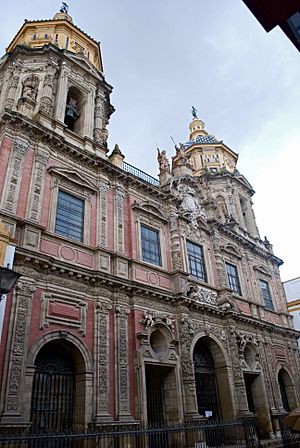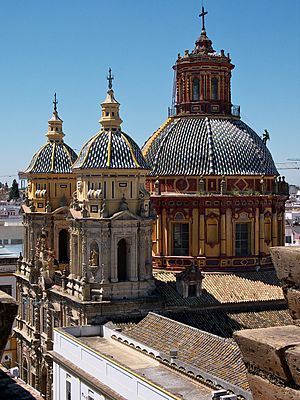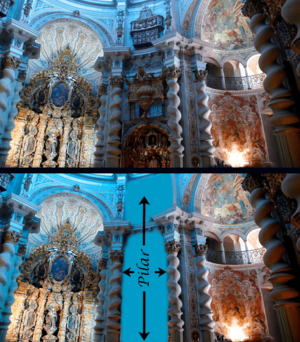Church of Saint Louis of France facts for kids
Quick facts for kids Church of Saint Louis of France |
|
|---|---|
|
Iglesia de San Luis de los Franceses
|
|
 |
|
| Religion | |
| Affiliation | Roman Catholic Church, Society of Jesus |
| Province | Sevilla |
| Region | Andalusia |
| Location | |
| Municipality | Sevilla |
| Country | Spain |
| Architecture | |
| Architect(s) | Leonardo de Figueroa |
| Architectural style | Baroque |
| Groundbreaking | 1699 |
| Completed | 1731 |
| Direction of façade | East |
The Church of Saint Louis of France (Spanish: Iglesia de San Luis de los Franceses) is a beautiful old church in Seville, Spain. It's a great example of Baroque architecture, a fancy style from the 1700s. The famous architect Leonardo de Figueroa designed it. Construction started in 1699 and finished in 1731.
This church was built for the Jesuits, a group of Catholic priests. After the Jesuits were forced to leave Spain in 1835, the church was used for many different things. It was even closed for a long time. Today, the building belongs to the Provincial Council of Seville [es].
Contents
History of the Church
The Society of Jesus, also known as the Jesuits, first came to Seville in 1554. They built a church, a house for their priests, and a place for new members to train. Only one of these original buildings, the Church of the Annunciation [es], still stands today.
Why the Church Was Built
In the early 1600s, a woman named Lucia de Medina gave land for a new, bigger church. She had two conditions:
- She wanted to be buried in the church's chapel.
- The church had to be named after her favorite saint, Saint Louis.
Saint Louis was Louis IX of France, a medieval king of France. He was also the brother of King Ferdinand III of Castile and León, who famously took back Seville.
Another reason the Jesuits chose Saint Louis was to build a good relationship with the Spanish royal family. At that time, the new French royal family, the House of Bourbon, had just started ruling Spain with King Philip V. The Jesuits wanted to show their loyalty and avoid being forced to leave Spain. You can see symbols like crowns and the fleur de lis (a French royal symbol) inside the church. These symbols show the strong connection between the kings and the Catholic church.
Construction and Changes Over Time
By 1609, the training house for new Jesuits had already moved to the new location. The main church building began construction in 1699 and was completed in 1730. In 1731, Archbishop Luis de Salcedo y Azcona officially opened the building as the Church of Saint Louis of France.
However, the Jesuits had to leave the church in 1767. This happened because King Carlos III ordered all Jesuits to be expelled from Spain. They returned for a short time in 1817, but another expulsion in 1835 forced them to leave for good.
After the Jesuits left, the building was used for many different things. It was a seminary (a school for priests), a convent, a hospital, a factory, and even a hospice. The church itself remained closed and wasn't used for religious services for many years.
Unlike many other churches in Seville, Saint Louis was lucky. It was saved from destruction during the fires of 1936. Because it was closed and unused for so long, many of its original designs and features have been wonderfully preserved.
Modern Day Use and Restoration
Today, the church is owned by the Provincial Council of Seville [es]. This group has been working to restore the church since 1984. They even worked with the Seville Endesa Foundation to add special artistic lighting inside. On September 6, 2016, the most recent renovations were finished. This allowed the public to visit the church and see its amazing art and architecture.
Church Architecture
The Church of Saint Louis of France is a stunning example of Baroque design. Its features were carefully planned to create a special experience for visitors.
Church Orientation
The church is built in a special way that follows the path of the sun in the sky. This means the main altar, which faces west, gets lots of natural light, especially in the spring. The main entrance faces east, towards the rising sun. Even the altars for specific saints, like Saint Stanislaus Kostka (north) and Saint Francis Borgia (south), receive light on their special feast days.
Exterior Design
The outside of the church, called the facade, has two levels. Each level is decorated like a fancy altar screen, called a reredo. The building uses a mix of stone and brick. Two tall, eight-sided towers stand on either side of the facade.
The second level has five windows. The middle window is framed by twisting columns called Solomonic columns. Above this central window, you can see the Spanish coat of arms with three archangels above it. The facade doesn't actually show the true size or shape of the church inside. The Jesuits had planned to build a large open space in front of the church so everyone could see the whole dome and facade, but this plaza was never built.
Interior Design
The church's floor plan is shaped like a Greek cross, which means all four arms are equal in length. A large cupola (a dome-shaped roof) sits in the center. It looks like sixteen twisting Solomonic columns hold up the heavy dome. However, the dome is actually supported by four hidden stone pillars. These pillars are cleverly disguised as part of the interior chapels.
Four smaller altarpieces, four balconies, and four decorative screens (called latticeworks) help hide these main support pillars. Out of the sixteen twisting columns you see, only two half-columns near the main altar are original. The rest were added during the 2016 restoration. The stone pillars themselves are covered with a smooth plaster (stucco) but are not painted.
Above the main entrance, under the choir area, are paintings dedicated to Saint Ignatius of Loyola, who founded the Jesuits. These were painted around 1743 by Domingo Martinez. One painting shows Saint Ignatius above a grand archway, which represents divine wisdom. This arch holds a book of his famous Spiritual Exercises.
On the sides of the entrance, two large paintings use allegory (symbolic stories) to defend the Jesuits. They show two important documents from the Pope that approved the Jesuits and their spiritual teachings. One painting even includes figures from Greek mythology, the three graces: Aglaea (joy), Thalia (obedience), and Euphrosyne (delight). They represent giving, accepting, and returning good deeds.
The Church of Saint Louis was a novitiate, a place where new Jesuit members were trained. Because of this, the church is full of symbols with many meanings. Above the main door, you can read, "This is the door of God, the righteous enter through it." The church was a place for learning and reflection, where people were meant to focus on their spiritual journey.
The architect used a technique called "theatrical repetition." This means he repeated certain elements to create a strong visual effect. Sometimes it's through symmetry, like two equal parts. Other times, it's repeating a single design, like the four images of Saint Ignatius. You can find eight-pointed stars, the fleur de lis, spirals, Solomonic columns, and images of saints repeated throughout the church and its chapel.
The altarpieces (decorated screens behind altars) have many curved Venetian mirrors. These mirrors, made of tin and mercury, reflect light, making the church seem brighter and larger. They also remind visitors of the motto "speculum sine macula" (mirror without blemish), which is linked to the Virgin Mary. The church also includes reminders that life doesn't last forever, like the eight skulls you can find.
The Cupola (Dome)
When you enter the church, you can look straight up into the dome. It has large windows that let in lots of light. On the inside of the dome, opposite the entrance, you'll see a painting of Religio, which represents religion itself. She is shown with a cross on her right and a palm leaf on her left. Both are symbols connected to Christ.
The beautiful paintings around Religio were done by Lucas de Valdés. They include symbols from both the Old and New Testaments of the Bible. You can spot a menorah, the Altar of Incense, the Ark of the Covenant, and the Eucharist (Holy Communion).
The pillars that support the dome represent eight important virtues. These virtues are linked to the Beatitudes, which are blessings taught by Jesus. Starting from the figure of Religio and moving clockwise, they are:
- CHARITAS PROXIMI - Love of Neighbor; This means being kind and merciful to others.
- CASTITAS - Chastity; This means having a pure heart.
- ORATIO - Prayer; This means seeking what is right and good.
- HUMILITAS - Humility; This means being humble and accepting challenges.
- MORTIFICATO - Mortification; This means being able to handle sadness and difficulties.
- OBIENTIA - Obedience; This means being gentle and cooperative.
- PAUPERTAS - Poverty; This means being humble and not focused on material things.
- CHARITAS DEI - Love of God; This means working for peace.
See also
 In Spanish: Iglesia de San Luis de los Franceses (Sevilla) para niños
In Spanish: Iglesia de San Luis de los Franceses (Sevilla) para niños
- List of Jesuit sites




